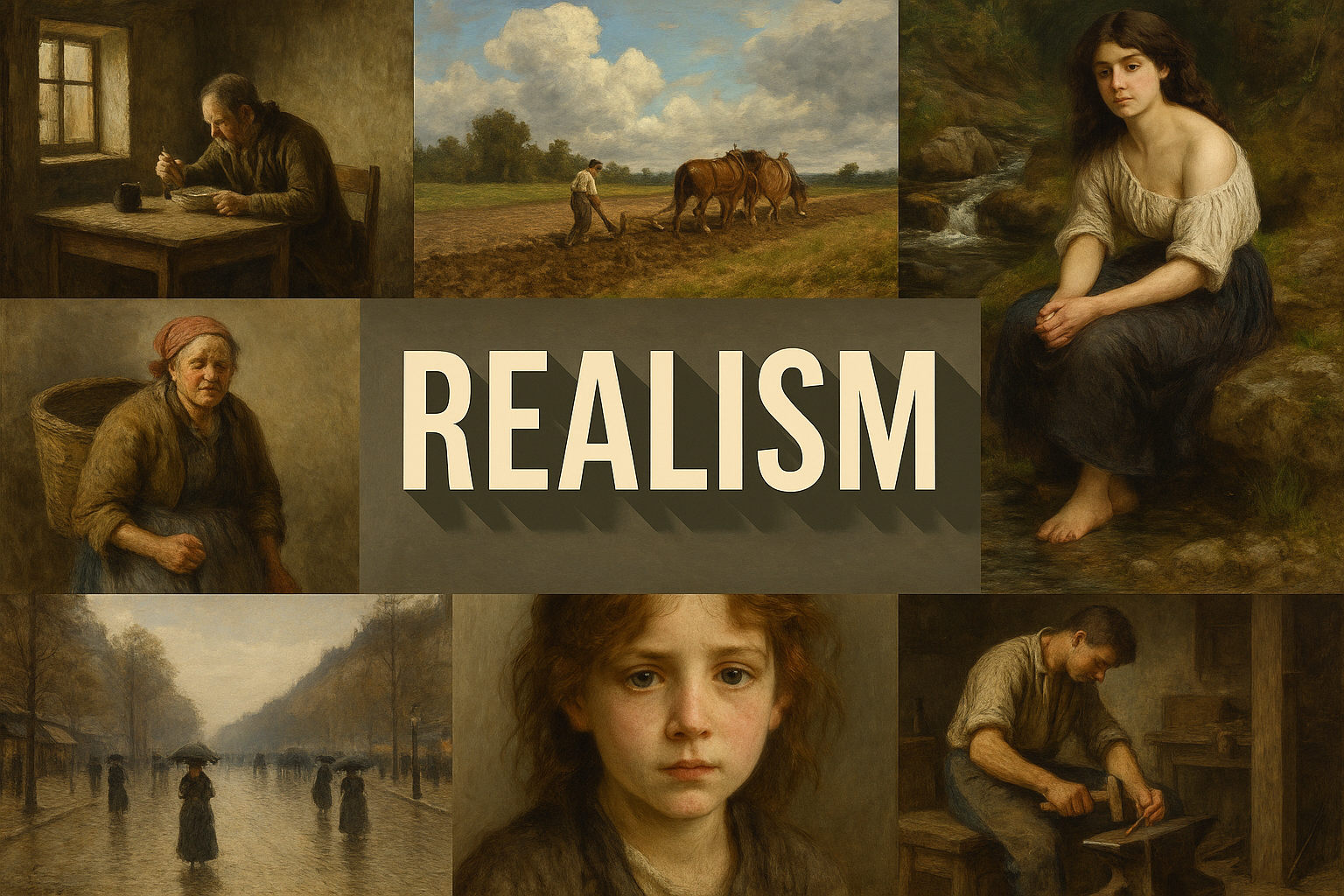
Realism
The art style of realism is characterized by its realistic and detailed depiction of subject matter. This style is often associated with the 19th century, and was a reaction against the previous art movements of romanticism and abstraction.
AOI thinking about Realism [+_~]-/
Overview and Quickfacts
Realism is a style of art that depicts subjects as they appear in everyday life. This style emerged in the mid-19th century in France and quickly spread throughout Europe and America. Realist artists sought to capture everyday scenes and people in a realistic and accurate manner. This style is still popular today, and many artists continue to create realistic works of art.
Can understand it also, as:
Truthful, accurate, genuine, authentic
Categorize it as:
Impressionism, Modernism
.: Dreaming :.
holds a HAIKU for the art style
:. Thought is power .:
Detailed Description
Realism is an art style that emerged in the mid-19th century in France. It is characterized by its accurate and detailed depiction of the world, as well as its commitment to realism in both its subject matter and its style. Some of the most famous artists associated with realism are Gustave Courbet, Jean-FranÃÂçois Millet, and HonorÃÂé Daumier. Courbet’s The Stone Breakers (1849) and The Gleaners (1857) are often cited as quintessential examples of the style. Realism was a reaction against the idealized and often unrealistic depictions of the world that were common in earlier art styles such as Romanticism. Realists sought to show the world as it actually was, warts and all. This often led them to tackle subjects that were considered taboo at the time, such as poverty, violence, and sexuality. Despite its commitment to realism, realism is not without its own stylistic conventions. Artists often used dramatic lighting and bold compositions to create an emotional impact, and they often exaggerated the size of their subjects to emphasize their power or importance. Realism was a major force in 19th-century art, and its influence can still be seen in the work of many contemporary artists.
.. beep, beep, beep ..
<START OF TRANSMISSION>
1. Realism is a movement that began in the mid-19th century in France. 2. It spread to other countries, including the United States, England, and Russia. 3. The main goal of realism was to represent people and society as they actually were, rather than how they were supposed to be. 4. This meant that artists began to paint everyday people in everyday settings. 5. One of the most famous realist painters was Gustave Courbet, who painted The Stone Breakers, which showed two peasants working in a field. 6. Other well-known realist artists include HonorÃÂé Daumier, Jean-FranÃÂçois Millet, and Andrew Wyeth. 7. Realism was also a literary movement, and one of the most famous realist writers was Gustave Flaubert, whose novel Madame Bovary was a realistic portrayal of a woman's life in 19th-century France. 8. Other well-known realist writers include Leo Tolstoy, Mark Twain, and Henry James. 9. Realism was also a movement in theatre, and one of the most famous realist playwrights was Anton Chekhov, whose plays often dealt with the everyday lives of ordinary people. 10. In the late 19th and early 20th centuries, realism began to give way to other movements, such as impressionism, post-impressionism, and cubism.
<EOF>
.. robbel bob
Visual Examples from our image gallery
Coming soon, we are so slow .. might never come
Artists, Paintings, and more
(be aware, can be highly speculative)
Artists (be aware, speculation possible):
1. William Adolphe Bouguereau (1825-1905) 2. Gustave Courbet (1819-1877) 3. HonorÃÂé Daumier (1808-1879) 4. Jean-Baptiste-Camille Corot (1796-1875) 5. Thomas Eakins (1844-1916) 6. Winslow Homer (1836-1910) 7. Edward Hopper (1882-1967) 8. Andrew Wyeth (1917-2009) 9. Richard Diebenkorn (1922-1993) 10. Chuck Close (1940- ) 11. John Singer Sargent (1856-1925) 12. Mary Cassatt (1844-1926) 13. James McNeill Whistler (1834-1903) 14. Frederic Remington (1861-1909) 15. George Bellows (1882-1925) 16. Thomas Hart Benton (1889-1975) 17. Grant Wood (1891-1942) 18. Reginald Marsh (1898-1954) 19. John Sloan (1871-1951) 20. Raphael Soyer (1899-1987) 21. Ben Shahn (1898-1969) 22. George Tooker (1920-2011) 23. Andrew Wyeth (1917-2009) 24. Edward Hopper (1882-1967) 25. Georgia O’Keeffe (1887-1986) 26. Frida Kahlo (1907-1954) 27. Diego Rivera (1886-1957) 28. Jose Clemente Orozco (1883-1949) 29. David Alfaro Siqueiros (1896-1974) 30. Rufino Tamayo (1899-1991)
Artworks (be aware, speculation possible)
1. American Gothic, Grant Wood, 1930 2. The Hay Wagon, Andrew Wyeth, 1953 3. Christina’s World, Andrew Wyeth, 1948 4. The Promenade, Edward Hopper, 1953 5. Nighthawks, Edward Hopper, 1942 6. A Sunday Afternoon on the Island of La Grande Jatte, Georges Seurat, 1884-86 7. The Bedroom, Vincent van Gogh, 1888 8. The Potato Eaters, Vincent van Gogh, 1885 9. The Third of May 1808, Francisco Goya, 1814 10. The Hay Wagon, Andrew Wyeth, 1953 11. The Gleaners, Jean-Francois Millet, 1857 12. The Sower, Jean-Francois Millet, 1850 13. The Stone Breakers, Gustave Courbet, 1849 14. The Gare Saint-Lazare: Arrival of a Train, Claude Monet, 1877 15. Wheatstacks (End of Summer), Claude Monet, 1891 16. A Bar at the Folies-Bergere, Edouard Manet, 1882 17. Olympia, Edouard Manet, 1863 18. The Absinthe Drinker, Edgar Degas, 1876 19. The Luncheon on the Grass, Edouard Manet, 1863 20. Young Girls at the Piano, Pierre-Auguste Renoir, 1892 21. The Dance Class, Edgar Degas, 1874 22. The CafÃÂé Concert, Edouard Manet, 1879 23. The Railway, Claude Monet, 1877 24. Boulevard des Capucines, Claude Monet, 1873 25. The Hay Wagon, Andrew Wyeth, 1953 26. The Gare Saint-Lazare: Arrival of a Train, Claude Monet, 1877 27. Wheatstacks (End of Summer), Claude Monet, 1891 28. A Bar at the Folies-Bergere, Edouard Manet, 1882 29. Olympia, Edouard Manet, 1863 30. The Absinthe Drinker, Edgar Degas, 1876
Epoch
The time period of the art style Realism is the late 1800s.
AI ART RESSOURCES (AKA, well Tools)
Helping tools -> predefined search links on other pages:










